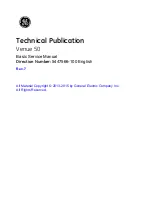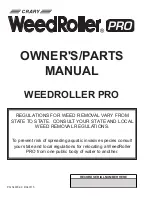
DirectFlo DF1400
Chapter 5: Trouble-Shooting and Repair
Comco Inc.
5-8
Issue Date: January 2009
Tank Cover Feedthru Bushing Replacement Procedure
1.
The bushings are bonded into the cover with an anaerobic retaining
adhesive. Remove the bushings by twisting out with a Spiral
–Flute
Extractor.
2.
Before installing the new bushing(s) (PF2055) carefully scrape out any of
the old bonding compound and thoroughly clean the hole in the cover.
Also thoroughly clean the surfaces of the bushing prior to bonding.
3.
Bond the new bushing(s) into cover with Locktite 680 retaining compound
or equivalent. Allow to cure for at least 1 hour before use.
4.
Install new O-rings.
The Handpiece Nose
The handpiece nose is the main part of the handpiece that holds the nozzle. The nose
holds together the abrasive hose, handpiece tube and the nozzle. Abrasive will wear
away the inside of the nose to a point where it can no longer support the hose. Also, if
the nozzle is not tightened firmly into the nose, abrasive leakage will wear away the
threads and the nozzle will not fit properly. Refer to Appendix B, Figure 8.
Handpiece Nose Replacement Procedure (PF2090)
1.
Remove the nozzle.
2.
Unscrew the handpiece tube from the nosepiece and slide it back.
Because of the static guard (spring) on the hose, it may be necessary to
hold or tape the handpiece back out of the way.
3.
Remove the hose from the nosepiece (it may be easier to cut hose).
4.
Slip the hose onto the nosepiece. Sometimes a little moisture helps.
5.
Screw on the handpiece tube.
6.
Install the nozzle.
The Abrasive Hose
The Abrasive Hose will eventually wear out and need to be replaced. The entire
Handpiece and Abrasive Hose Assembly (PF2406) can be replaced, or its individual
components. Most of the wear in the hose will be in the first 2 or 3 inches at the end that
exits from the PowderGate. The proper procedure for cutting and reinstalling the hose is
explained below.
CAUTION
:
Always use the proper hose when replacing a worn or
damaged abrasive hose. The use of a different hose or
a hose with a different pressure rating may present a
hazard.
















































